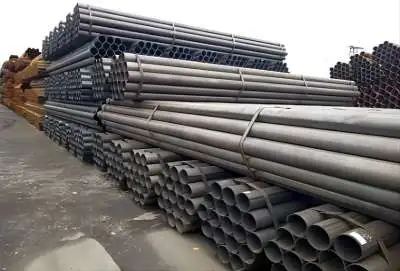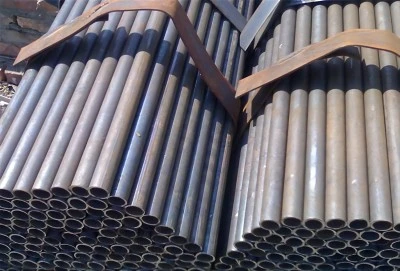Electric resistance welded (ERW) pipes have become an integral part of various industries, from oil and gas to construction and infrastructure. These pipes are known for their strength, durability, and cost-effectiveness, making them a popular choice for many applications. In this comprehensive guide, we'll explore the different types of ERW pipes, focusing on two main categories: Longitudinal Welded Pipe and Spiral Welded Pipe. We'll also provide insights on how to choose the right type for your specific needs.
|
|
|
Longitudinal Welded Pipe
Longitudinal welded pipes, also known as straight seam pipes, are a widely used variety of Electric Resistance Welded (ERW) pipes. The manufacturing process begins with rolling flat steel strips into a cylindrical shape. The edges of the steel strip are then welded together along the entire length of the pipe using an electric resistance welded pipe. This creates a continuous, straight seam that runs parallel to the pipe's axis. The process is highly efficient and can be applied to a wide range of pipe sizes and wall thicknesses, making longitudinal welded pipes versatile and suitable for a variety of applications in industries such as construction, oil and gas, and water transportation.
One of the primary advantages of longitudinal welded pipes is their uniform wall thickness. This consistency makes them ideal for applications that require precise dimensions and high-pressure resistance. Industries such as oil and gas, water transportation, and structural engineering often prefer longitudinal welded pipes for their reliability and strength.
The manufacturing process of longitudinal welded pipes involves several steps:
- Coil preparation: Steel coils are inspected and cleaned to ensure quality.
- Edge milling: The edges of the steel strip are prepared for welding.
- Forming: The steel strip is rolled into a cylindrical shape.
- Welding: High-frequency electrical current is applied to weld the edges together.
- Heat treatment: The welded area is treated to relieve stress and improve strength.
- Quality control: The pipe undergoes various tests to ensure it meets industry standards.
Longitudinal welded pipes offer excellent dimensional accuracy and are available in a wide range of sizes, typically from 1/2 inch to 24 inches in diameter. They are particularly suitable for applications that require long, straight pipe runs with minimal bends or curves.
Spiral Welded Pipe
Spiral welded pipes, also called helical welded pipes, are another type of electric resistance welded pipe with unique characteristics. These pipes are manufactured by continuously winding a steel strip in a spiral pattern and welding the edges together. The result is a pipe with a distinctive helical seam that wraps around its circumference.
The spiral welding process offers several advantages:
- Efficient material usage: Spiral welding allows for the production of larger diameter pipes using narrower steel strips.
- Increased flexibility: The spiral seam provides better flexibility for handling pressure fluctuations and external forces.
- Cost-effectiveness: For larger diameter pipes, spiral welding can be more economical than longitudinal welding.
The manufacturing process of spiral welded pipes includes the following steps:
- Coil preparation: Steel coils are inspected and prepared for welding.
- Edge preparation: The edges of the steel strip are beveled for optimal welding.
- Forming: The steel strip is fed into a spiral forming machine.
- Welding: The edges are welded together using submerged arc welding or other methods.
- Heat treatment: The welded area is treated to improve its mechanical properties.
- Quality control: The pipe undergoes rigorous testing to ensure it meets industry standards.
Spiral welded pipes are commonly used in large-diameter applications, typically ranging from 16 inches to over 100 inches in diameter. They are particularly suitable for water transmission lines, penstocks in hydroelectric projects, and offshore pipelines.
How to choose?
Selecting the right type of electric resistance welded pipe for your project depends on various factors. Here are some key considerations to help you make an informed decision:
- Diameter requirements: For smaller diameters (up to 24 inches), longitudinal welded pipes are often the preferred choice. For larger diameters, spiral welded pipes may be more cost-effective and easier to manufacture.
- Pressure ratings: Both types of ERW pipes can handle high pressures, but longitudinal welded pipes generally offer higher pressure ratings due to their uniform wall thickness.
- Application specifics: Consider the specific needs of your project. For example, if you need long, straight runs with minimal bends, longitudinal welded pipes might be more suitable. For projects requiring larger diameters or more flexibility, spiral welded pipes could be the better option.
- Cost considerations: Spiral welded pipes can be more cost-effective for larger diameters due to their efficient use of materials and manufacturing process.
- Industry standards: Ensure that the chosen pipe type meets the required industry standards and specifications for your specific application.
- Transportation and installation: Consider the logistics of transporting and installing the pipes. Spiral welded pipes may offer advantages in terms of handling and transportation for larger diameters.
It's important to consult with experienced engineers or pipe manufacturers to determine the best type of ERW pipe for your specific project requirements. They can provide valuable insights based on your project's parameters and help you make the most suitable choice.
Longma Group
Electric resistance welded pipes play a crucial role in various industries, offering strength, durability, and cost-effectiveness. Whether you choose longitudinal welded pipes for their uniform wall thickness and precise dimensions or spiral welded pipes for their flexibility and cost-efficiency in larger diameters, understanding the characteristics of each type is essential for making the right choice.
Longma Group electric resistance welded steel pipe is manufactured to meet a range of industry standards, ensuring quality and reliability. Adhering to specifications from API 5L, ASTM A53, ASTM A500, ASTM A252, and ASTM A795, these pipes are designed for various applications in the oil, gas, and construction industries, providing a robust solution for both structural and pressure piping needs. If you are choosing your electric resistance welded pipe manufacturers, welcome to contact LONGMA GROUP at info@longma-group.com.














